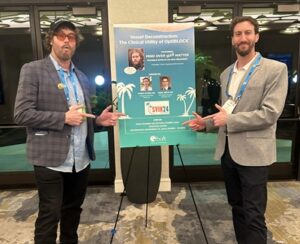
“Imagine if you saw construction workers building a house, and they were using a hammer or a saw, and you were like, ‘what the f*** is that?’”
This is the perspective comedian and actor T.J. Miller puts forward to explain his recent fascination with the devices and processes involved in treating arteriovenous malformations (AVMs). Miller underwent a successful embolisation procedure to remove a ruptured AVM from the right frontal lobe of his brain in 2010, but it wasn’t until a representative from leading neurovascular firm Balt approached him nearly 15 years later that he truly began to take an interest in how the condition is managed surgically.
“It had never been a part of my identity, and I think that’s really interesting,” he tells NeuroNews. “So, in working with Balt, I’ve been able to learn all about the equipment that’s used—which I think is fascinating—and I think it’s really helpful to better understand your injury, or disability.”
This quest for knowledge is what led Miller to the 2024 Society of Vascular and Interventional Neurology (SVIN) meeting (20–22 November, San Diego, USA), where he sat down with NeuroNews before giving a guest talk outlining his experiences as someone who has suffered from, survived and come to terms with a brain AVM.
From realisation to embolisation
Miller was in the middle of filming Yogi Bear 3D in the late 2000s when, in his own words, he started becoming “crazy”. Some light-hearted ‘for examples’ he gives here include becoming obsessed with disentanglement puzzles, and starting to narrate his own life and actions in real time. On a more serious note, he recalls having major difficulty sleeping, and using a combination of heavy drinking, medications and actively monotonous podcasts in an attempt to remedy this.
“I [later] asked my manager what he thought was going on and he was like, ‘I don’t know, I just thought you were on drugs’,” Miller recounts.
Following a period of increasingly erratic behaviour, Miller experienced two seizures—one during a meeting with his managers, and another while in hospital. He then came to in the neurocritical care unit at Cedars-Sinai Medical Center in Los Angeles, USA, and found that all of the other patients in the room were intubated and/or comatose.
“It was really heavy-duty stuff,” he says. “They told me I had an AVM and I, of course, didn’t know what that was. Then I found out they were usually [discovered] during autopsies—especially at the time—and that they’re very, very rare.”
Miller also recalls being informed of the embolisation procedure through which his AVM would be treated and removed. However, the fact this surgery was technically elective created a dilemma the like of which very few people under the age of 30 are ever faced with. Below is a rough transcript based on Miller’s memories of how this conversation went.
Miller: “What happens if I don’t do it?”
The intern tasked with explaining this situation: “You’ll probably die in your mid-30s.”
Miller: “Well, after the surgery, will I still be funny?”
Intern: “…what?”
Somewhat understandably, the neurological doctors at Cedars-Sinai had placed saving and prolonging Miller’s life at the top of their priority list. But Miller, whose performances typically rely on improvisation and standup ability, initially held reservations over the surgery if doctors couldn’t guarantee his comedic wit would be retained post-procedure.
“That’s what I do—it’s my purpose, and it’s sort of everything to me,” he states. “So, if I’m not going to be funny, then I think I’ll just take a pass. I’d had a good life and would’ve been fine to do another few years of being hilarious. This guy [Miller gestures to the aforementioned Balt representative, who also helped organise our interview] is going to live until he’s 90 but he hasn’t even said one funny thing in the last 48 hours. It’s a toss-up!”
Having been assured that the AVM was actually located in a part of the brain with little bearing on his award-winning drollery, Miller ultimately opted to “roll the dice” on the 10% fatality risk associated with this complex procedure.
The operation was successful, which Miller attributes to him being treated at one of the best hospitals in the world where they perform roughly three AVM embolisations every day. One detail he found particularly surprising was the fact that, despite having just undergone brain surgery, “they didn’t need me to do anything” in terms of rehabilitation—he was allowed to walk out of the hospital within a few days of the procedure.
Being an AVM survivor
Reflecting on the surgical and post-surgical care he received, Miller notes that the initial focus was on his functional outcomes, as opposed to any potential psychological repercussions of having part of his brain removed. He was referred to a world-class neurologist, prescribed an anti-seizure medication (levetiracetam) and—outwardly, at least—appeared to be doing well.
Five years after the surgery, Miller stopped taking levetiracetam and subsequently had another seizure—the only one he has experienced since his AVM ruptured. Then, in 2018, Miller suffered a manic episode, leading to a since-resolved incident that he describes as a “misunderstanding with the US federal government”. Looking back, Miller sees this moment as a blessing in disguise because it resulted in his attorney Stacey Richman introducing him to a neuropsychologist, Sejal Vyas from the Center for Cognition, Emotion and Behavior (New York, USA), to participate in a cognitive remediation programme.

Tests done by his neuropsychologist indicated that Miller held certain characteristics commonly associated with being bipolar or autistic, ultimately revealing the true extent of the cognitive side-effects—the “invisible disability”—stemming from his brain injury.
“She works with a lot of people with traumatic brain injuries [TBIs], and she told me, ‘your intelligence meant no one could’ve ever imagined that you had any cognitive deficits’,” Miller explains. “This actually made it more difficult for me, because people just think I’m forgetting their names, I don’t care about the names of their spouses or their dogs, I keep interrupting them, I talk for long periods of time—all those things just make me seem like an a**hole. But it’s been fascinating to learn about my own mind, and undergo this cognitive remediation where she begins to help me get better at managing and overcoming these challenges.”
Miller was subsequently placed on two further anti-seizure medications (lamotrigine and lacosamide) to regulate his brain activity, and began taking lithium to better control his mood swings. While these medications have had a positive effect, Miller also emphasises the profound impact of his neuropsychology appointments, which have enabled him to join the dots between his day-to-day struggles—forgetfulness, episodes of erratic behaviour, and dependence on alcohol and drugs in order to achieve sleep—and the surgery he underwent in 2010.
“If you don’t want to talk about it, then no one knows about it,” he says. “Everyone just thought I was crazy. And, in Hollywood, and in the arts in general, people just go, ‘well, he’s an actor’. It’s that tortured genius type of thing.”
Entering the neurovascular space
Miller did address his experiences as an AVM survivor in those years following the surgery—initially in conversation with fellow comic Pete Holmes on the You Made It Weird podcast in 2011, and then more prominently via a standup routine on an episode of the TV show This Is Not Happening in 2013. However, he only discussed his experiences publicly on a handful of occasions and, due to the rareness of the condition, even opportunities to speak to other people who have had a brain AVM are few and far between.
“Whenever I see an AVM survivor or somebody who has one, I’m the highest-profile person they know of and they’ve never even met anybody else with an AVM,” Miller says. “I’m part of a TBI support group, but none of those people have an AVM or know anybody who has an AVM. It is so incredibly rare.”
Miller credits the relationship he has developed alongside Balt over the past few months with him being able to “absorb” the repercussions of the brain injury as part of his identity, leading to his attendance at SVIN 2024 as well as the Society of NeuroInterventional Surgery (SNIS) meeting (22–26 July, Colorado Springs, USA) earlier in the year.
“In connecting with these types of conferences—and with people like yourself—I’m able to increase my visibility in this space and, hopefully, help raise awareness and share my story,” he adds. “The best thing in terms of my relationship with Balt is, the more you understand the procedure and the equipment that goes into this, the more that knowledge empowers you. And I never thought that’d be the case, but it was.
“I visited a facility yesterday and went into the room where they make all the catheters and coils and delivery systems, and it just helps you understand more of what they’re doing. I felt that, in speaking to Balt and getting involved with them, it made it possible for me to feel closer to what the surgery was and how it led to me being alive today.”
Moving forward, Miller is looking to further improve his own understanding of brain AVMs in addition to raising awareness of the condition for the benefit of fellow TBI patients; a group whose disabilities are often unseen, but whose voices should not go unheard.










